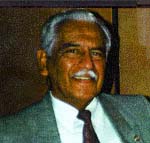
by
JOAB O. PACILLAS
National Historian
1973 - 1990 |
The FOUNDERS: John Parraz (deceased), Sacramento County Sheriff’s Department, and Vicente Calderon, California Highway Patrol, San Jose Office were very much aware of the small number of Latino Peace Officers throughout the State of California, and in October 1972 while attending a conference in Sacramento CA at the Miramar Hotel their idea, to start a Latino Peace Officers Association, was born. They began talking other individuals regarding the need for an Organization that could help improve the representation of Latino Peace Officers in the various Departments in California. A great number of hours and personal time was expended until these two officers were able to gather a small nucleus of Officers made up of members of Law Enforcement Agencies from Alameda, Sacramento, Santa Clara Counties, and the San Joaquin Valley.
These men were leaders and truly dedicated to the Goals and Objectives of an Organization that was still in its embryonic stage. One of these leaders, co-founder, and the First State President, John Parraz, passed away in March 1979. This gave impetus to a rededication of time and effort by those remembering the unselfish contributions made by this courageous Sergeant from the Sacramento Sheriff’s Department.
|
John Parraz presented Police Chief William Kenney (center) with a sombrero on the Chief's retirement.
The event was held in Sacramento CA in the late 1970's
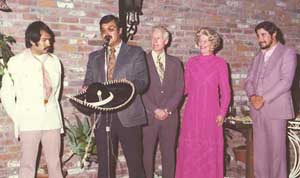
Victor Sanchez, John Parraz, Sacramento Police Chief William Kenney & Wife and Jorge Madrigal
|
On August 7, 1974, the Articles of Incorporation of the Latino Peace Officers’ Association of California were filed in the Office of the Secretary of State, March Fong Eu. This step was taken after three years of unofficial meetings with a few interested Peace Officers working in the counties of Alameda, Santa Clara, Sacramento, and the San Joaquin Valley.
This historical event, unprecedented in the history of any State or National Law Enforcement oriented organization, gave official recognition to a Hispanic Law Enforcement group, from all levels, legitimately concerned with increasing the number of Latinos in Law Enforcement agencies in California. The successful and sincere efforts of its members have come to command the respect of other professional organizations and local communities that previously looked at Hispanic Peace Officers with distrust.
Five courageous Peace Officers signed their name to this historical document at the risk of eliciting negative comments from their fellow officers and their departments. Their unselfish and unrelenting commitment to the goals of recruitment, hiring, training, retention and promotion of qualified Hispanics into the field of law enforcement, has been an inspiration to other officers who have continued to work towards these goals.
The original signers of the incorporation documents were: John Parraz (deceased), Sacramento County Sheriff’s Department;
Vicente Calderon, California Highway Patrol, San Jose Office; John Aleman, Oakland Police Department; Mariano Flores, California Highway Patrol, Fresno Office; and Richard Reyes (deceased), San Jose Police Department.

John Parraz |

Vicente Calderon |

John Aleman
|

Mariano Flores
|

Richard Reyes
|
The first Annual State Convention was held at the Paraiso Restaurant in Fresno, California, on November 23, 1974, under the presidency of John Parraz. This could have been called "An Organizational Convention". The whole morning session centered around the structure, purpose, objectives, membership, and the Constitution and By-Laws of the newly-formed Latino Peace Officers’ Association.
The Luncheon Speaker was Dr. Armando Morales, Author of "Ando Sangrando". A panel discussion was held in the afternoon on "Latinos In Law Enforcement". The moderator for this panel was Richard Reyes. The two speakers were: Daniel Campos, Director of Affirmative Action and Al Villa, Attorney at Law.
It can safely be assumed that there was a great deal of interest expressed during the first convention and the interest generated continued to grow as the years went by. Unfortunately, there is very little documentation of minutes for meetings/correspondence from its original members that would indicate or show what activities each chapter was undertaking. Therefore, this information is missing from the History of the Latino Peace Officers’ Association.
Elections were held and Vicente Calderon was elected President for the year 1975-76.
El Puente:
The Latino Peace Officers’ Newsletter was developed in 1975 by Barbara Ponze, Rosa Maria Hernandez and Vicente Calderon who was also the first editor. Mr. Fred Caballero, a friend who operated a printing company was very instrumental in assisting with the lay out and printing of this first rate newsletter. The newsletter was published on less than a shoe string budget, and Mr. Caballero’s time, energy and material were donated. We hounded poor Fred so much that he would say, "son como borachos, tercos y necios!". The initial newsletter format consisted of two pages with information on both sides of the sheets.
|
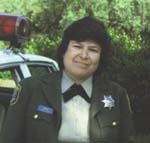
Barbara Ponze
The first Female to hold the Office of NLPOA Chapter President
(Santa Clara Chapter).
|
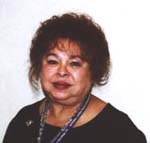
Rosa Maria Hernandez
(Santa Clara Chapter)
|
There is no doubt that the four chapters that had been formed up to this time had difficulty getting started with their membership drives. Some of the Chapters had meetings in which minutes were taken. However, the only information available so far is on meetings held by Alameda and Santa Clara County Chapters.
The Barbara Ponze Story
The first female officer to join the National Latino Peace Officers Association and serve as a Chapter President.
Barbara was born in the small town of Madera CA. She was one of eight children who were reared by their mother as they grew up in East San Jose and Milpitas. Barbara, went through San Jose area schools and graduated from Samuel Ayer High School in Milpitas in 1961. She studied law enforcement at San Jose State University and other area colleges, joining the Santa Clara Sheriff’s Department on January 10, 1966.
Barbara’s first assignment was in the jail where most Deputies start their law enforcement careers. While working in the jail, on the grave yard shift, she met Vicente Calderon who was a California Highway Patrol Officer working in the San Jose area. When Vicente arrested drunk drivers he would bring them to the jail and always talk to Barbara about NLPOA.
“It was their baby” said Barbara, Vicente and John Parraz spent all of their time trying to get the Association going. Vicente started the Santa Clara Chapter in San Jose California and was always trying to get me to join”. Later, after I joined the chapter, Richard Reyes, Louis Cobarrubias and myself traveled around the state getting other chapters started.
Barbara’s career changed, after a civil suit forced the County to allow females to transfer out the jail and into patrol. Of course, Barbara was the first female Deputy to work the streets of Santa Clara County.
In 1975 the first association newspaper was started by Vicente Calderon, Barbara Ponze and Rosa Maria Hernandez. The newspaper was called the El Puente.
In 1987 Barbara was elected president of the Santa Clara County Chapter. Barbara, now a detective, was the first female in the organization to head an N.L.P.O.A. Chapter.
Barbara went on to prove herself by serving on the Tactical Team, at the police academy, and in then the courts. While serving in the courts she was tasked with the enormous responsibility of developing a “risk assessment protocol”, for moving prisoners safely through the court system. Again Barbara was the first. She became the first “Risk Management Officer” for the Department.
Barbara retired in 1996 but didn’t stop there. She went on to Mills College where she earned a degree in Anthropology and Sociology. Barbara was then hired by the Federal Job Core where she served as a Senior Staff Official. Barbara is retired now living in Madera with her daughter Louisa and two adopted daughters Mia and Hillary. Barbara is a long-standing member of the N.L.P.O.A. and has made many contributions toward the success of the organization. Through her hard work and active participation, she has earned the respect of all N. L. P. O. A. members.
Santa Clara Chapter:
The Santa Clara County Chapter was started by Vicente Calderon when he worked in San Jose CA. The chapter had approximately 30 members, 22 of them were from the San Jose Police Department. The Chapter officers were: Richard Reyes, President;
Lou Cobarrubias, Vice President; Carlos Paredes, Recording Secretary; and Ray Mendiola, Corresponding Secretary.
Ray Mendiola, exhorted the membership into getting more involved by attending more meetings. He felt that discussions had to continue on important and relevant issues affecting Latino Peace Officers.
At that time, The San Jose Police Department had 445 officers of which only 34 (7.6%) had Spanish Surnames. The main issue at hand was a Civil Rights investigation conducted as the result of the allegation that the City of San Jose was in violation of Office of Revenue Sharing hiring requirements, and that the Police Department discriminated against Mexican-Americans because of their national origin. Yet, the Mexican-American population of San Jose was approximately twenty-two percent (22%). Soon after these statistics were published, eight (8) Spanish-Surname officers were eliminated from the Field Officers Training Program. This meant that the percentage of Hispanics in the San Jose Police Department dropped to (1.8%).
This issue was of great importance to the San Jose LPOA Chapter and had important implications which could affect other Police Departments, not only in California, but any city where Revenue Sharing monies were expended. One individual who stands out for his courage and dedication was Joe Lopez. He filed a class action suit through the courts against the County of Santa Clara and was successful in generating a consent decree from the court. His courage and suffering because of his ideals is a story in its own right.
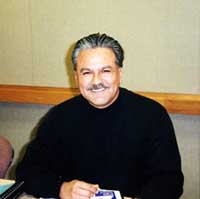
Joe Lopez, now a Sergeant
with the Santa Clara Sheriff Dept.
On August 6, 1975, the Director of the Office of Revenue Sharing, John K. Parker, wrote a letter to Mayor Janet Hayes requesting that the City of San Jose implement its Affirmative Action Plan to include specific goals and time tables until the Police Department reflected the percentage of minorities in that City, and that the City of San Jose validate the Field Training Program. Some of the other requests made were that the City reinstate, with back pay, the Mexican-American Officers who were fired via the Field Training Program.
The following offices were reinstated: Gilbert DeHoyos, Greg Montoya, Luis Lopez, Hugo Gonzales, Daniel Mercado, Manuel Nunez, M. Rios, E. Hurtado, M. Higuera, N. Cordova, and Art Paniagua, Oakland Police Department; S. Ferdin and Jerry Ornelas, East Bay Regional Parks Disstrict; R. Cruz, San Leandro Police Department; J. Leon, Union City Police Department; and M Hinojose, Federal Bureau of Investigation.
Height Requirement:
In 1976 Association members testified before the California State Personnel Board, along with a Japanese group from San Francisco regarding the height entrance requirement for the California Highway patrol. As a result of our presentation, the height requirement was eliminated, opening the door for admission to the CHP for women and minorities who until then had been denied entrance due to statue.
Bilingual Pay:
Also, L.P.O.A. initiated bilingual pay within the California Highway patrol. As a result, the majority of large police agencies within the state of California implemented the program. Later, additional state agencies were authorized bilingual pay. Since then, bilingual pay has become part of the negotiations process throughout the United States.
Recruitment of new members into the Alameda County chapter was one of the main objectives for this group. This chapter’s membership felt that the local chapters needed all the help to get the organization really going and that it was the responsibility to the "mother" chapters to meet the need of the home chapters first before expanding to other parts of the state.
In the meantime, an interesting phenomenon was taking place in the Southern part of the State. A young and energetic California Highway Patrolman, Carlos Cruz, Pomona Office, was busy trying to start an LPOA Chapter in San Bernardino.
Carlos, out of curiosity like many others, attended the First LPOA Convention in Fresno in 1974. He also thought that it would be a good idea for Latino "policemen" to get together and exchange ideas on how to better the plight of the Hispanics in Law Enforcement. However, the members of the San Bernardino group balked at the idea of joining the State LPOA Organization. The San Bernardino groups concern seemed legitimate due to the newness of the Association.
For example, they wanted to know if the State Organization was made up of a large and rigid group of "Northerners" who would be unconcerned with the needs of the people "in the South". Some of the questions asked were: What does the State Organization have to offer? What impute will the southern Chapters have that will have an impact on their concerns? Why is a State Organization necessary? And, how does the LPOA intend to accomplish its goals?
On April 14, 1975, three members of the State Board traveled to San Bernardino to meet with a group of the local Peace Officers to try to assuage some of their concerns by answering their questions. The State Officers included President Vicente Calderon, Sgt at Arms Ray Mendiola, and LPOA NEWS LETTER Editor, Louis Cabarrubias.
The meeting went well and the San Bernardino group voted to join the state LPOA. There was also a group of Police Officers from San Diego who wanted to find out what the LPOA was all about. This group had already formed an organization, La Placa Social, in the south and were considering joining the Latino Peace Officers’ Association.
Today N. L. P. O. A. is the largest Latino law enforcement organization in the United States with chapters serving communities from California to New York. Our members consist of peace officers from federal, state and local levels throughout the country. Membership is also available to non peace officers, as Associate members.
The Main Objectives of NLPOA are:
1. Recruitment of qualified Latino Peace Officers
2. Recruitment and assistance to those officers while engaged in their probation periods.
3. Education. Encourage and assist officers in the participation of training and
educational programs in their respective Departments, and
4. Assistance for members to engage in the promotional process.
|
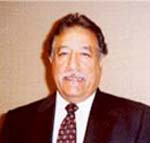
Lou Espindola
|
In 1980, Lou Espindola was on of the original founders of the Brotherhood of Mexican American Police Officers of Phoenix, Arizona. Later, Lou along with the other members decided to become part of the National Latino Peace Officers Association. Being part of N.L.P.O.A. gave the Phoenix Latino Officers "National Voice" which helped
Lou resolve many disputes between Latino Officers and police agencies. Unlike California, Arizona doesn't have police unions to represent their officers, which makes N.L.P.O.A. a very important part of the Latino Community. |
|
Citizenship Outreach Program:
Beyond these objectives, the Chapters have extended their concern by reaching out into their communities by responding to their needs in various ways, and according to the needs of each individual community. |
|
In 1995, Proposition 187 passed in California witch motivated legal Hispanic residents to become United States Citizens. Andrew J. Cruz, President of the Sacramento Chapter, developed and coordinated an annual "Citizenship Day" event, using chapter members along with other community groups like La Cooperativa. N.L.P.O.A. provided free finger printing, identification photographs, and assistance filling out I.N.S. forms. This unselfish effort and important community service helped thousands of legal residents become United States Citizens. |
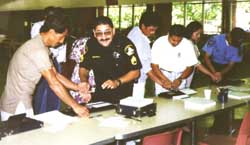 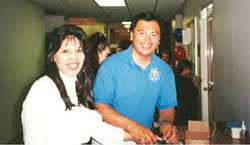
|
| |
Sgt. Richard Madrigal, Sac. Sheriff's Dept. & Officer Oscar Saldana Sac. Police Dept. |
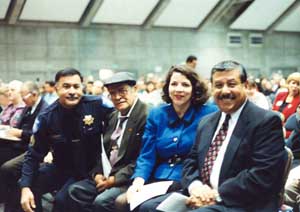
|
Police Sergeant Andrew Cruz, Sacramento Police Department, Jaime Escalante, State Senator Deborah Ortiz, and Mayor Joe Serna, Mayor of Sacramento, attend the swearing in ceremony of 4,000 New Hispanic United State Citizens. |
|
|
El Protector Program:
When California Highway Patrol crash data indicated that the incidence of Hispanic people involved in fatal motor vehicle collisions was significantly higher than the general population, Jorge Chaidez, from the Fresno Chapter, developed a program called the El Protector Program for the California Highway Patrol. This program was a pro-active traffic safety outreach program directed at the Hispanic community. This bilingual/bicultural program provided public education through dialogue with the Hispanic community. Jorge’s radio talk show proved to be the most effective phase of the program.
Scholarship Program:
The interest in youth has prompted chapters to sponsor a variety of fund raising functions to raise money for scholarships to help young people interested in entering the Criminal Justice System. Ruben Sanchez, President of the Sonoma Chapter, working with Rene Lopez, Vice President, formed a committee that developed a perpetual scholarship fund through the Santa Rosa Junior College System in memory of Deputy Drank Trejo, who was killed in the line of duty. On the committee were Teresa Guererro, Jose Avila, Daniel Marquez, and Louis Nunez.
Christmas Program:
Christmas baskets have been a traditional project on a yearly basis for chapters. Gabe Cervantez, President of the Alameda Chapter, developed a program that provides Christmas baskets and hot meals to hundreds of needy families in Oakland California. Local community people and organizations have welcomed these valuable donations.
Youth Programs:
The interest in youth has also prompted chapters to sponsor Mentor Programs, Role Model Programs, Tutoring Programs as well as Anti-Gang Seminars, to assist young people interested in entering the Criminal Justice System as Police, Probation/Parole, and Correctional Officers; District Attorney Investigators, Deputy Sheriffs, and other Municipal, County, State, and Federal Peace Officers related fields.
Senior Programs:
Senior Citizens groups, a growing segment of the communities, have also benefited from the concern of the LPOA members. Breakfasts, dances and other recreational activities have been sponsored by LPOA.
Support Programs:
One of the projects close to every member’s heart is the concern for fellow officers and family members of those who have died or have been injured in the line of duty. Contributions have been made to their loved ones to help out in their trying moments.
Training Programs:
The LPOA sponsors yearly Training Conferences to help promote the professionalism of its members and other interested individuals. A variety of subjects are offered in order to help the participating members become better acquainted with new laws, techniques, and also learn from the experiences of fellow officers in the Criminal Justice System.
Mentor Program:
There have been meetings with other segments of the Criminal Justice System in order to offer each other help in developing and exploring ideas to better serve the different law enforcement agencies in their respective communities. From one of these meetings. Eli Molina, California Highway Patrol, identified a need for a mentor program to assist new officers after they completed the academy and were transferred to a new area. Eli explained that the CHP was loosing Hispanic Officers and a mentor program was needed to provide support and guidance to these new officers. Carlos Marquez, Jose Vasquez, from California Highway Patrol along with Andrew J. Cruz, from the Sacramento Police Department, put together a mentor program and introduced it to LPOA in 1995. The program was accepted and endorsed by Gary Dominguez and Jose Miramontes, National and California State Presidents, respectfully.
All in all, the Latino Peace Officers’ Association continues to make an effort to "be in tune with the times" not only on social issues, but also politically. In order to become more effective in the latter, THE NATIONAL LPOA PAC., was formed. This political action committee meets Federal and State requirements and operates separately from the regular Association.
National Presidents:
The following individuals have served as National Latino Peace Officers Association Presidents. Several of the below mentioned individuals served more than one term and not always concurrent. Also, the term of office was changed to 2 years during Quijas last term in office and the following Presidents served 2 years as indicated below.
1. John Parraz, Sacramento Sheriff’s Department, 2. Vicente Calderone, California Highway Patrol 3. Carlos Cruz, California Highway Patrol 4. Fernando Aldacoa, Santa Ana Police Department 5. Angel Gaitan, Alhambra Police Department 6. Paul Camparan, California Patrol 7. Ruben Diaz, Santa Clara Sheriff’s Department 8. Lou Quijas, Kansas City Police Department 9. Juan DeLeon, Houston Police Department 10. Gary Dominguez, California Highway Patrol 11. Andrew J. Cruz, Sacramento Police Department 12. Adrian Garcia, Houston Police Department 13. Jose Carlos Miramontes, Los Angeles County Sheriff's Department, Felipe Ortiz, U.S. Probations, Roy Garivey, Houston Police Department and Police Chief Art Acevedo, Austin Police Department. . |
NLPOA's First Business Manager Under Contract.
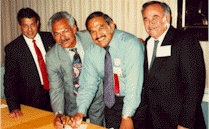
First Business Manager, Gene Reyes signs a contract
with N.L.P.O.A. in 1988.
From (left to right) Eddie Cervantes, Gene Reyes,
Ruben Diaz and Ben Rubidoux.
|
Mr. Gene Reyes was the first Association Manager and served from 1988 to 1995. Mr. Reyes began his tenure under President Lou Quijas and continued with the presidents that followed. Mr. Reyes directed the Association in legal matters and directed the transition of the Association from a 501 (c) (6) to a 501 (c) (3) non-profit organization, with IRS tax exempt status. Mr. Reyes also established the Association's first Political Action Committee and coordinated several statewide fundraisers. Mr. Reyes along with N.L.P.O.A. President Ruben Diaz and the C.C.W.A.'s President authored the language for the original document that eventually became the organization called The National Coalition of Hispanic Law Enforcement Association. |
In 1994, the National Convention held in San Jose California. Gary Dominguez, California Highway Patrol, was elected National President, Daniel Hernandez, Kansas City Police Department, was elected Vice President and Fred Sainz, L.A. District Attorney’s Office, was elected Treasurer.
In April 1995, an excellent training conference was held in Las Vegas, hosted by the Clark Co. Chapter. The conference was a enormous success. Alvin Cruz, from the National Council of La Raza (NCLR) Wash. DC, instructed members on how to organize and operate a non-profit organization. Also, at this conference Dr. Armando J. Islas was appointed Chairman of our National Political Action Committee. The name of the PAC was "THE NATIONAL LPOA PAC" and Lorenzo Provencio, from the San Diego Chapter, was appointed parliamentarian.
President Dominguez, knowing that communication and networking would be extremely important in maintaining a successful Association, wanted to develop a National Newsletter that would be delivered to each member individually. Felipe Ortiz, Nevada State President, recommended we obtain a non-profit bulk mail permit to reduce the cost of the newsletter.
After some discussion Andrew J. Cruz, Sacramento Chapter President, was asked to take on this monumental task. Andrew was already publishing an excellent and informative newsletter in Sacramento and the executive board felt Andrew was the man for the job. The following week Andrew obtained the non-profit permit and began publishing the newsletter. At first, chapters were reluctant to send in their rosters but soon the mailing list was over 1,000 and by 1997 it was over 5,000.
In October 1995, the National Conference was held in Albuquerque, New Mexico, hosted by the Bernalillo Chapter. At this meeting President Dominguez disclosed that the job of running an Association the size of NLPOA, with just four board members, was overwhelming. Therefore, three new board members were appointed and approved by the membership. Adrian Garcia, Houston Police Department, was appointed Second Vice President, Patricia Mora, California Highway Patrol, was appointed Secretary, and Andrew J. Cruz, Sacramento Police Department, was appointed Historian.
National By-Laws:
John Messina, our general counsel, the delegates, and the National Board spent what seemed like hours negotiating the new By-Laws. After much discussion the By-Laws were overwhelmingly approved. John Messina was assigned to write the By-Laws and have them sent to every member. A notable change in the By-Laws was that now Associate members could serve on the National Board, but not hold the office of President or Vice President. In April 1996, the new By-Laws were mailed to every member on our mailing list, via the National Newsletter.
New National Historian:
While preparing the history of the Association Andrew Cruz contacted Joab Pacillas, San Gabriel Valley Chapter, who had served as National Historian form 1973 to 1990. During his ten-year Joab wrote a history of NLPOA which was never published.
Andrew was working with Joab when Joab passed away in May 1996, after suffering from a long illness. Andrew completed Joab’s work and published THE HISTORY OF LPOA, in memory of Mr. Joab O. Pacillas, in May 1996. |
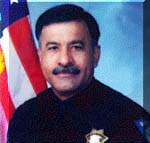
Andrew J. Cruz
|
NLPOA.COM
In 1999, Mr. Andrew J. Cruz established the first web site for the Association. Within the web site each N.L.P.O.A. Chapter had it own web page. The first, of many, fruits from the web site were from Ohio. Mr. Rolando Belmares, Deputy Sheriff from Lucas County found the Association in the web. |
On February 5th, 2000 Mr. Belmares traveled to Sacramento CA and attended the California State Meeting. Mr. Belmares stayed at the California Highway Patrol Academy for four days while he visited Sacramento. After meeting the California Chapter Presidents he started his own chapter in Ohio.
The Future:
Needless to say, the National Latino Peace Officers Association is on the move and definitely impacting the communities and Law Enforcement Agencies where the members participate. Growth is inevitable and expansion and influence of this organization will be much more evident as time goes on.
It should be noted that the words Latino, Hispanic, Mexican American and Chicano are used interchangeably throughout this paper only because the writer has opted not to revise too much of the original and limited material obtained. Therefore, the writer has exercised the privilege of plagiarizing in the writing of this History.
The format followed is simple. An effort has been made to acquaint the reader with the different Chapters’ this will give the reader and idea of how the NATIONAL LATINO PEACE OFFICERS’ ASSOCIATION has developed to its present stature.
Thus, the NLPOA continues to grow and to take a prominent place in the "community" of organizations in this great country. |
|